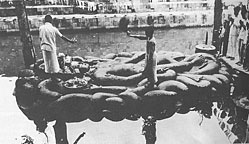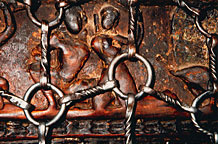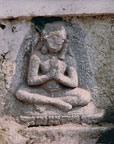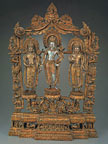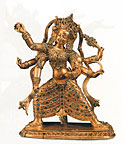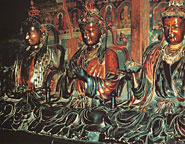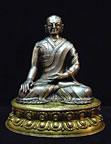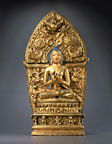Footnotes:
1. The gold horses measure 4.4.cm x 2.4 cm. These artifacts were first studied in Kaogu 2001/6: 45-47 (Xizang zhizhiqu shannan diqu wenwuju, “Xizang langkarzi xian chajiagou gumuzang de qingli”, reproduced in Heller 2003a, fig. 1. The silver deer (5.6 x 3.5 ) was studied by Xu Xing Guo in Khrung guo zang xue 1994/4:136.
2. Xu Xinguo, chief archeologist, analysed the gilding technique of this reliquary as cladding, a Sogdian technique, rather than fire-mercury gilding commonly found in Tibet and Nepal in Xu, Krung go zang xue 1994/4. See Heller 1998 for photographs of the reliquary (heller 1998, Orientations ).
3. See Backus 1981, p.28, n. 79 for bridge technology; Demiéville, Paul, 1987: Le Concile de Lhasa, Paris (reprint of 1952), p.203 for armour.
4. Pelliot, Paul, 1961: Histoire Ancienne du Tibet, Librairie d’Amérique et d’Orient A. Maisonneuve, Paris, p.6 for the goose ewer; Demiéville, Paul, 1987: Le Concile de Lhasa, Paris (reprint of 1952), p.203 for the ewer and a miniature golden city decorated with animals and men on horseback ; Schaefer, Edward H., 1963: The Golden Peaches of Samarkand, University of California Press, Berkeley and Los Angeles: p.254, and note 42 citing Tang Annals’ descriptions of gold objects in Tibet for the years 734, 735, 805, 817, 827, 837 AD.
5. Wangdu, Pasang and Diemberger, Hildegard, 2000: Dba’ bzhed. The Royal Narrative concerning the Bringing of the Buddha’s Doctrine to Tibet, Verlag der Österreichischen Akademie der Wissenschaften, Wien.: p.56 and note 166.
6. The Fifth Dalai Lama describes this jar in his Catalogue of the Jokhang written in 1645. For discussion of the silver jug and ancient Tibetan silver vessels, see particularly Carter 1998, as well as Heller 2002 and Heller 2004. Richardson 1998, 254, Carter 1998, 39, fig.14, Heller 2002/2004, Knauer 1998, 101,fig.70, attributed to Tibetan workmanship; Schroeder 2001, 792-795, pl. 190 A-D, attributed this jug to Sogdian workmanship of 8th century.
7. Richardson, Hugh E., 1998: Two Chinese Princesses in Tibet, in: High Peaks, Pure Earth, Collected Writings on Tibetan History and Culture, Hg.: Richardson, H.E., with an introduction by Michael Aris., 207-215, Serindia, London, U.K. , p.208-209, discusses the 7th century Chinese princess, the later weaving of legends about her introduction of Buddhism and construction of temples. He concludes that much of what is attributed to her is more likely to be the activities of the 8th century Chinese princess Kong Jo who was also sent to marry a Tibetan emperor.
8. Lévi, Sylvain, 1905: Le Népal, etude historique d’un royaume hindou, vols. 1-2., Ernest Leroux, Paris., p.163-5. Slusser, Mary S., 1982: Nepal Mandala A Cultural Study of the Kathmandu Valley, vol.1-2, Princeton University Press, Princeton, USA, p.39 discusses the Licchavi kings’ practice of Hindu religion as well as non-sectarian patronage, including royal foundations of Buddhist monasteries.
Slusser, Mary S., 1982: Nepal Mandala A Cultural Study
of the Kathmandu Valley, vol.1-2, Princeton University Press,
Princeton, USA, p.33-34 explains the improbability of the
Tibetan tradition of a marriage alliance with a Nepalese princess.
Although this tradition is regarded as fact today, this Nepalese
princess is unknown in either ancient Nepalese or Tibetan historic
sources prior to the 11th century.
9. See Slusser, Mary S. and Vajracharya, Gautamvajra,
1973.: Some Nepalese Stone Sculptures: A Reappraisal within
their Cultural and Historical Context, In: Artibus Asiae,
p.35 (1-2), p.79-138. and Slusser, Mary S., 1982: Nepal
Mandala A Cultural Study of the Kathmandu Valley, vol.1-2,
Princeton University Press, Princeton, USA,, pl. 376
10. Weldon, David, 2000:
Tibetan Sculpture Inspired by Earlier Foreign Sculptural Styles.
In:
Oriental Art46 (2), 47-56.,
p.49, fig. 8 draws attention to this alignment of legs in Licchavi
art.
11. Siudmak, John, 2000. The Development
of the Classical Buddha Image from Kashmir, and some Observations
on Kashmirian Influence on the Sculpture of West Tibet. In:
Oriental Art 46 (2), figs. 3, 4. and for the most thorough
study see Hinüber, Oskar von, 2004: Die Palola Sahis,
Ihre Steinischriften, inschriften auf bronzen, handscriftenkolophone
und schutzzauber. Materialien zur Geschichte von Gilgit und Chilas.
Verlag Philipp von Zabern, Mainz, 2004. I thank Professor Oskar
von Hinüber for correspondence on the chronology of these
statues.
12. Klimburg, Maximilian, 1982: The Setting:
The Western Trans-Himalayan Crossroads ,in: The Silk Route
and The Diamond Path, Hg.: Klimburg –Salter, Deborah. UCLA
Art Council, Los Angeles, USA, 24-37. for Trans-Himalayan routes;
Heller, Amy, 1998: Two Inscribed Fabrics and their Historical
Context: Some Observations on Esthetics and Silk Trade in Tibet,
7th to 9th Century.in: Entlang der Seidenstrasse. Frühmittelalterliche
Kunst zwischen Persien und China in der Abegg-Stiftung. Hg: Otavsky,
Karel. Riggisberger Berichte 6, Riggisberg, Schweiz, 95-118. for
Tibet and silk trade; Sims-Williams, Nicolas, 1996: The Sogdian
Merchants in China and India , in: Cina e Iran da Alessandro
Magno alla dinastia Tang,Hg.: Cadonna, Alfredo and Lanciotti,
Lionello, Leo S. Olschki Editore, Firenze, 45-67. for trade from
Sogdiana to India.
13. I am indebted to Professor Pasang Wangdu
for photographs of this stele which he discovered in 1985. See
discussion in Heller, Amy, 1998: Two Inscribed Fabrics and
their Historical Context: Some Observations on Esthetics and Silk
Trade in Tibet, 7th to 9th Century.in: Entlang der Seidenstrasse.
Frühmittelalterliche Kunst zwischen Persien und China in
der Abegg-Stiftung. Hg: Otavsky, Karel. Riggisberger Berichte
6, Riggisberg, Schweiz, 95-118., p.113, fig. 51.
14. Vitali, Roberto, 1990: Early Temples
of Central Tibet. Serindia Publications, London, p.1-37.
15. Karmay, Heather, 1975: Early Sino-Tibetan
Art, Aris and Philips. Warminster., p.4; see also sBa bzhed
and Wangdu, Pasang and Diemberger, Hildegard, 2002, p.65.
16. This passage was quoted in Weldon, D. und
Singer, Jane Casey, 1999: The Sculptural Heritage of Tibet,
Buddhist Art in the Nyingjei Lam Collection, Laurence King,
London.: p.14.
17. Alsop, Ian, 1990: Phagpa Lokeshvara
of the Potala. In: Orientations Magazine 1998 (Art
of Tibet, Selected articles from Orientations 1981-1997), p.81-91,
discusses multiple copies of the sacred statue Phagpa Lokeshvara
of the Potala; Alsop, Ian, 2000: Copies in Tibetan Sacred
Art, Two Examples. In: Oriental Art, N. S. 46(2),
4-13, discusses this statue further as well as another sacred
statue.
18. Pal, Pratapaditya, 2003: Himalayas,
An Aesthetic Adventure, The Art Institute of Chicago in association
with the California Press and Mapin Publishing, Chicago p.85,85
and p.87: Schroeder, 2000, plate 41 B-E; Heller, Amy,
2003: The Three Silver Brothers. In: Orientations
34(4), 28-34.
19. Postel, Michel, 1989. Ear Ornaments
of Ancient India, Project for Indian Cultural Studies, Publication
2, Bombay. , pl. V.39, a 9th/10th c. stone Tara in the Patna Museum.
20. I thank John Siudmak for the reference to
Foucher, Alfred, 1913. Les Images indiennes de la fortune.
In: Mémoires concernant L’Asie Orientale,
L’Académie des Inscriptions et Belles Lettres, Ernest
Leroux, Paris, p.123-138., pl. 13.
21. Vitali, Roberto, 1996. The Kingdoms
of Gu.ge Pu.hrang according to the mNga’.ris rgyal.rabs
by Gu.ge mkhan.chen Ngag.dbang grags pa, Tho.ling gtsug.lag.khagn
lo.gcig.ston ‘khor.ba’i rjes.dran.mdzad sgo’i
go.sgrig tshogs.chung, Dharamsala., 313 for the discussion of
the artist from Magadha in Toling ca. 1000 AD.
22. Schroeder, Ulrich von, 2001: Buddhist
Scultpures in Tibet, 2 Bde., Bd. 1: India & Nepal; Bd.
2: Tibet & China, Visual Dharma Publications, Hongkong, p.330,
pl. 111B.
23. Weldon, D. und Singer, Jane Casey, 1999:
The Sculptural Heritage of Tibet, Buddhist Art in the Nyingjei
Lam Collection, Laurence King, London, p.21-22, notes 22-23,
figs. 11-15.
23a. The inscription reads, “ pur pa ‘de sa
ho‘i ”, Tibetan transliteration of sorts for pūrvadeśa,
“(belonging to) the eastern country”, ie. Eastern India, probably
Bengal, where the sculpture may have been made ca. late 11th.
24. Schroeder 1981, 248 details the Muslim raids
in India of 11th and 12th century which led the monks to bury
images. Huntington/ Huntington 1990 already presented sculptures
attributed to Indian workmanship in Tibet, however, they concluded
that there was “no detectable wave of artistic influence”
after Muslim raids and rather that “the Pala artistic idioms
were already so thoroughly integrated into Tibetan culture, and
Tibetan knowledge of the Pala idioms was so current, that even
a new wave of émigrés did not visibly alter the
artistic direction”. However, Tibetan historical sources
do not document the constant presence of Indian artists in Tibet.
Sporadic references of one or two individual masters are found,
but the numerous works attributed to Indian production in Tibet
presuppose the existence of several ateliers of Indian artists
in Tibet during 12th-13th century, and these are not yet historically
documented. Is it not possible that much of the production was
by Nepalese artists in Tibet emulating Indian styles? While no
evidence of Indian artists settled with ateliers at that time
in Tibet is documented at present, there were possibly areas in
Bangladesh and E India which were less dismantled than the main
areas destroyed further East (to Bihar and Bengal) and in these
areas of (present-day) Bangladesh and East India, possibly sculptures
might still have been cast. This topic remains to be investigated
in the future by art historians, while the historical context
of this research on surviving Saiva and Buddhist micro-kingdoms
is on-going by Professor Alexis Sanderson (see his forthcoming
volume: Religion and the State: Initiating the Monarch in Saivism
and the Buddhist Way of Mantras, Heidelberg, Harrasowitz Verlag,
Ethno-Indological Series, now in press.)
25. Weldon, D. und Singer, Jane Casey, 1999:
The Sculptural Heritage of Tibet, Buddhist Art in the Nyingjei
Lam Collection, Laurence King, London, p.61-65, figs. 28-33;
Schroeder, Ulrich von, 2001: Buddhist Scultpures in Tibet,
2 Bde., Bd. 1: India & Nepal; Bd. 2: Tibet & China, Visual
Dharma Publications, Hongkong, pl. 85 a-e; Huntington/Huntington
1990, fig. 135, attributed to Tibet, late 11th to early 12th century.
26. Martin, Dan, 2001: Painters, Patrons
and Paintings of Patrons in Early Tibetan Art, in: Embodying
Wisdom, Art, Text and Interpretation in the History of Esoteric
Buddhism, Hg.: Linrothe, R. und Sørensen, H., The Seminar
for Buddhist Studies Monographs 6, 139-184, Kopenhagen, 142-144.
27. Lo Bue, Erberto, 1997. The role of Newar
Scholars in transmitting the Indian Buddhist Heritage to Tibet
(c. 750-1200) in: Les Habitants du Toit du Monde. Hg: Karmay,
S. and Sagant, P. Société d’Ethnologie, Nanterre,
France, 629-658. Newar Scholars, 633 passim.
28. Schroeder, Ulrich von, 2001: Buddhist
Scultpures in Tibet, 2 Bde., Bd. 1: India & Nepal; Bd.
2: Tibet & China, Visual Dharma Publications, Hongkong, p.220,
pl. VII-6 and pl. 169c
29. See most recently the photographs of Professor
Fosco Maraini republished in Lo Bue, Erberto, 1998: Tibet,
Templi scomparsi fotografati da Fosco Maraini. Turin.
30. Heller, Amy, 2003: The Silver Jug of
the Lhasa Jokhang: Some observations on silver objects and costumes
from the Tibetan Empire (7th –9th century). In: Silk
Road Art and Archeology 9, p.213-237., 45, figs. 17 and 19
(here 2003 = Grathang article).
31. Heller, Amy, 1999: Tibetan Art, Tracing
the Development of Spiritual Ideals and Art in Tibet, 600-2000
A. D., Jaca Book, Antique Collector’s Club, Milano
pl.69-70, citing L. van der Kuijp 1995, 922-923, for
the identification of the donor.
32. Stoddard, 1985
33. Béguin, Gilles, 1990: Art ésotérique
de l’Himâlaya, Catalogue de la donation Lionel Four-nier.
Musée national des arts asiatiques Guimet, Paris, p.54,
considered Stoddard’s attribution to Aniko as “gratuitous”.
34. Alsop, Ian, 1994 and Alsop, Ian, 1997.
35. Alsop, Ian 1994, fig. 1, and Alsop, Ian,
1997, fig. 50.
36.Roerich, George N. 1996: The Blue Annals,
von Gö Lotsawa Zhönu Pal [’gos lo tså
ba gzhon nu dpal], Teil 1 & 2, übers. von G. Roerich,
Calcutta 1949, Reprint Motilal Banarsidass Publishers, Delhi,
p.580, 583, 584, 607.
37.Tucci, Giuseppe, 1956: To Lhasa and Beyond,
Diary of the expedition to Tibet in the year 1948. Istituto
Poligrafico Dello Stato, Roma, p.128; Mele, 1969, for photographs
of Densatil during Tucci’s expedition.
38. Pal, Pratapaditya, 2003: Himalayas,
An Aesthetic Adventure, The Art Institute of Chicago in association
with the California Press and Mapin Publishing, Chicago, p.217-218,
pl. 140.
39. Tucci, Giuseppe, 1956: To Lhasa and
Beyond, Diary of the expedition to Tibet in the year 1948.
Istituto Poligrafico Dello Stato, Roma, p.128; Pal, Pratapaditya,
2003: Himalayas, An Aesthetic Adventure, The Art Institute
of Chicago in association with the California Press and Mapin
Publishing, Chicago, p.217 concurs with Tucci’s opinion.
40. Lo Bue, Erberto F. und Ricca, F., 1993:
The Great Stupa of Gyantse, A Complete Tibetan Pantheon of
the Fifteenth Century, Serindia Publications, London, p.24,
and pl. 4 E 2 for the Chinese throne.
41. See Béguin,1993, fig. 5.
42. Lo Bue, Erberto, 1997. Sculptural Styles
According to Pema Karpo. in: Tibetan Art Towards a Definition
of Style., p.253.
43.Lo Bue, Erberto, 1997. Sculptural Styles
According to Pema Karpo. in: Tibetan Art Towards a Definition
of Style., p.253.
44.Weldon, D. und Singer, Jane Casey, 1999:
The Sculptural Heritage of Tibet, Buddhist Art in the Nyingjei
Lam Collection, Laurence King, London, p. 90.
45.The inscription on this sculpture:
" ston pa'i sku 'di gsang phu gling srad (sic) kyi gdan sa
pa chos rje shes rab dpal ldan bzang po'i thugs dam du bzhengs."
"this noble sculpture of the teacher was
made as the personal image of the Chief Abbot of Sang pu Monastery
(gsang phu gling srad kyi gdan sa pa) the Choje Sherab palden
zang po (chos rje shes rab dpal ldan bzang po)."
That is what the inscription says, literally..
This sculpture was made for Sherab palden zangpo, the Chief Abbot
of the monastery (there were several small monastic residences,
he was the head of the whole monastery.) He was still alive in
1476, having ruled already 2 years as chief abbot.
In view of the fact that he had recently assumed
the abbot's throne, he had probabl y performed in 1475 the one-year
commemoration ceremony of the previous abbot, Sangye Chopa, who
had ruled for 14 years until his death. It is a very long reign
and he was a great teacher. In my opinion, it is clear that this
sculpture represents the teacher Sangye Chos pa and was made to
be the personal meditation image of Sherab palden zangpo, to be
a reminder of his predecessor and mentor.
The history of the lineage of the abbots of Sangpu monastery is
found in Tibetan historic sources, but also in the English translation
of one very reliable history book, The Blue Annals. The discussion
of Sang pu and the lineage of abbots is page 329 (Roerich
1996, p. 329)
46. Weldon, David, 2000:
Tibetan Sculpture Inspired by Earlier Foreign Sculptural Styles.
In: Oriental Art 46 (2), p.53-56, figs. 21-28; Schroeder 2001, pl.178 A-C; Schroeder 2001, 796-819, pl. 191-194.
47. The author has studied and translated this
inscription as personal research in 2004.
Inscription on statue:
Om svasti/ rmad byung tshogs gnyis chu
gter dbus su
'khrungs/ rnam dag byang chub spyod pa'i khams las grub//
'phags sras gser ri'i dbus na nyer mdzes pa// thub dbang rin
chen rdul brtsegs la phyag 'tshal// chos dpal chen 'am mgon
bsam 'grub rab brtan gyi thugs kyi dgongs pa yongsu rdzogs
par gyur zhing/ bdag nyi zla ma bu 'khor dang bcas pa la
mchog thun mong gi dngos grub ma lus pa brtsal du gsol// bzo
rig bal po bzo su dza 'dzo tri sogs dbang po ' grangs can kyis
sgrubs// bkra shis//
Translation :
Om Svasti.
To honor the memory* of the glorious
Ah mgon bSam grub rab brtan, in the hopes that Nyi Zla mother
and child(ren) and all sentient beings may attain the superior
and the mundane levels of spiritual realization, the Nepalese
workmanship (i.e. the creation of the prabha) is the achievement
of the master artist Su Dza dzo ti** , the sculptor of infinite
prowess.
May there be praise to Buddha who is most precious***,
(he who is) the noble son in the center of the golden mountain
of beautiful offerings, he who has totally perfected the practices
leading to enlightment as the result of the karma of birth in
the center of the ocean combining the two excellent conditions
( = wealth and religion, ie. Shakyamuni Buddha was born as prince
Siddhartha and he had religious aspirations). May there be happiness!
Notes :
* literally, « to completely fulfill the intentions or spirituel
aspiriations, » in analogy to the Buddha whose death was
his mahaparinirvana. Thus this is an idiomatic expression, it
means « to die ». so when an image is made in complete
fulfillment of the person's desires, it means that it is an image
made soon after the person's death, usually for the one year commemorative
ceremony.
** Gautam Vajracarya suggests this is a transliteration
of Surya Jyoti, a common Newar name, particularly for the Udas;
Dan Martin suggest the possibility of Sujana Jyoti. My thanks
to them both.
*** literally, the mighty sage of precious
particles all piled up together.
|
|

